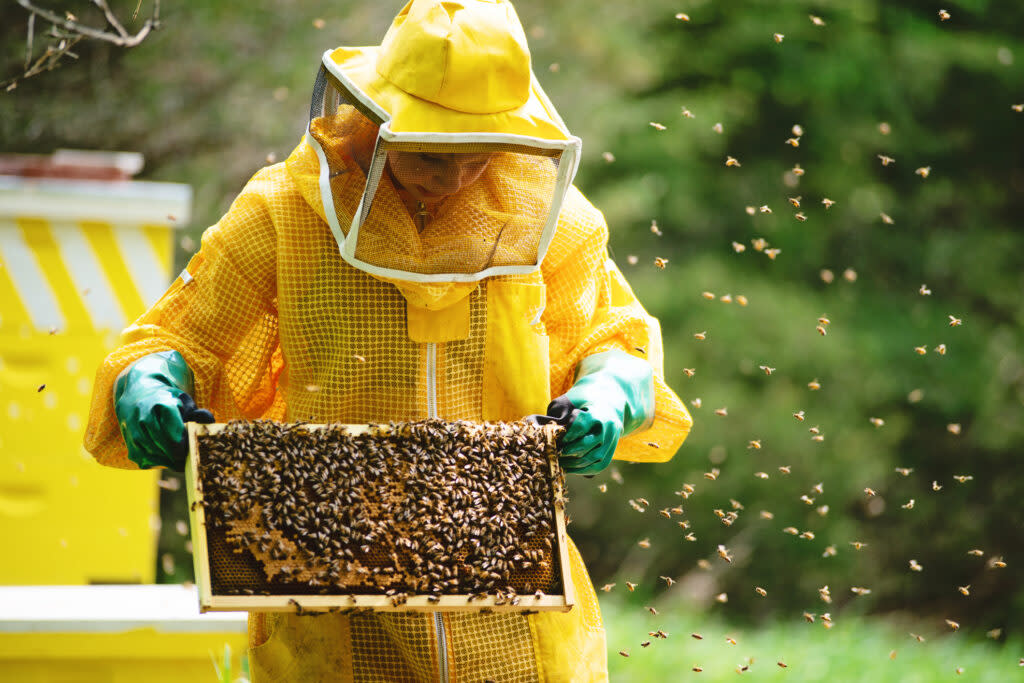Seeds treated with neonics: Bad for bees, the environment and human health

A beekeeper checking frames and caring for the hive. Photo by Getty Images.
Over 14 million acres of Minnesota croplands such as corn and soy are planted with neonicotinoid (“neonic”) treated seeds.
As a beekeeper, such widespread use of an insecticide known to harm bees is extremely concerning.
Do the benefits of these pesticides outweigh the harm to my bees and my livelihood?
Research on the benefits of neonicotinoid seed treatments in corn and soybean suggest the answer is a resounding “no.”
Extensive studies of this subject by Cornell University and the EPA conclude that these treatments provide “no net economic benefit to farmers.”
These studies are affirmed by farmers elsewhere: Europe prohibited neonicotinoid treatments 10 years ago, and Quebec has effectively phased them out over the past five, yet production levels remain consistent, with no noticeable effect on yield in either the EU or Canada.
Meanwhile, neonicotinoid treatments are causing widespread harm.
Neonics are extraordinarily toxic to bees, aquatic bugs, and a wide variety of other life.
At least 95% of the neonic coating doesn’t enter the plant as intended; instead, it remains in the environment, contaminating wild plants, wildlife, surface waters and groundwater.
Insect predators that farmers count on for natural pest control are also eliminated, oftentimes decreasing yield as a result and requiring additional insecticidal spraying.
Neonics also harm soil health by killing insects and microbial life critical for capturing carbon and nutrient cycling.
Pollinators — including managed honeybees — are severely impacted by neonicotinoids. This lost pollination on high-value crops such as soy amounts to millions of dollars lost to Minnesota farmers.
Lost honey production and soaring bee losses cost Minnesota beekeepers millions.
Neonics have also been linked to various human health problems.
Research has connected neonics exposure to neurological, developmental and reproductive problems, including abnormal heart and brain development, reduced testosterone levels and birth defects.
For children, the risk of these health outcomes is greater. Worse still is the widespread reach that these pesticides seem to have.
Early CDC monitoring found neonics present in the bodies of half the U.S. population. Alarmingly, the highest levels were found in children. A more recent study of pregnant women has found neonics present in the bodies of over 95% of participants nationally, suggesting significantly higher rates of exposure despite the growing body of research raising concern about health implications.
Increasing human exposure also mirrors a pair of studies by the Minnesota Department of Natural Resources finding neonics in 61% of deer in 2019 and, just two years later, finding them in 94% of deer statewide.
Neonics are among the most ecologically disastrous pesticides since DDT. And they are everywhere in Minnesota.
How do neonics work? Plants treated with neonics absorb the chemicals, rendering their leaves, nectar, pollen and fruit toxic to insects. Neonics are so toxic that a single treated seed can be potent enough to kill a quarter of a million bees — and kill, they do.
In a recent review by the EPA, it was discovered that neonics are driving over 200 species toward extinction — some of which are key pollinators.
The good news is that our state has already recognized the dangers of pesticides, and some regulations are already in place to protect people and the environment from these chemicals. But because treated seeds are not considered to be pesticides under state law, they are not subject to these crucial safeguards.
We need new legislation to protect our state from the dangers of neonics. One bill in particular, HF2472 (known as the “Treated Seed Bill”), would make strides in the protection of Minnesota’s agriculture, environment, and community health by addressing this regulatory loophole and ensuring seed treatments are only used as needed
The children and wildlife of Minnesota — and my bees — are never acceptable collateral, and our state deserves a future unburdened by the dangers that neonics present. With people, pollinators, and the future of our food supply at risk, there is no time for more delay.
The post Seeds treated with neonics: Bad for bees, the environment and human health appeared first on Minnesota Reformer.

